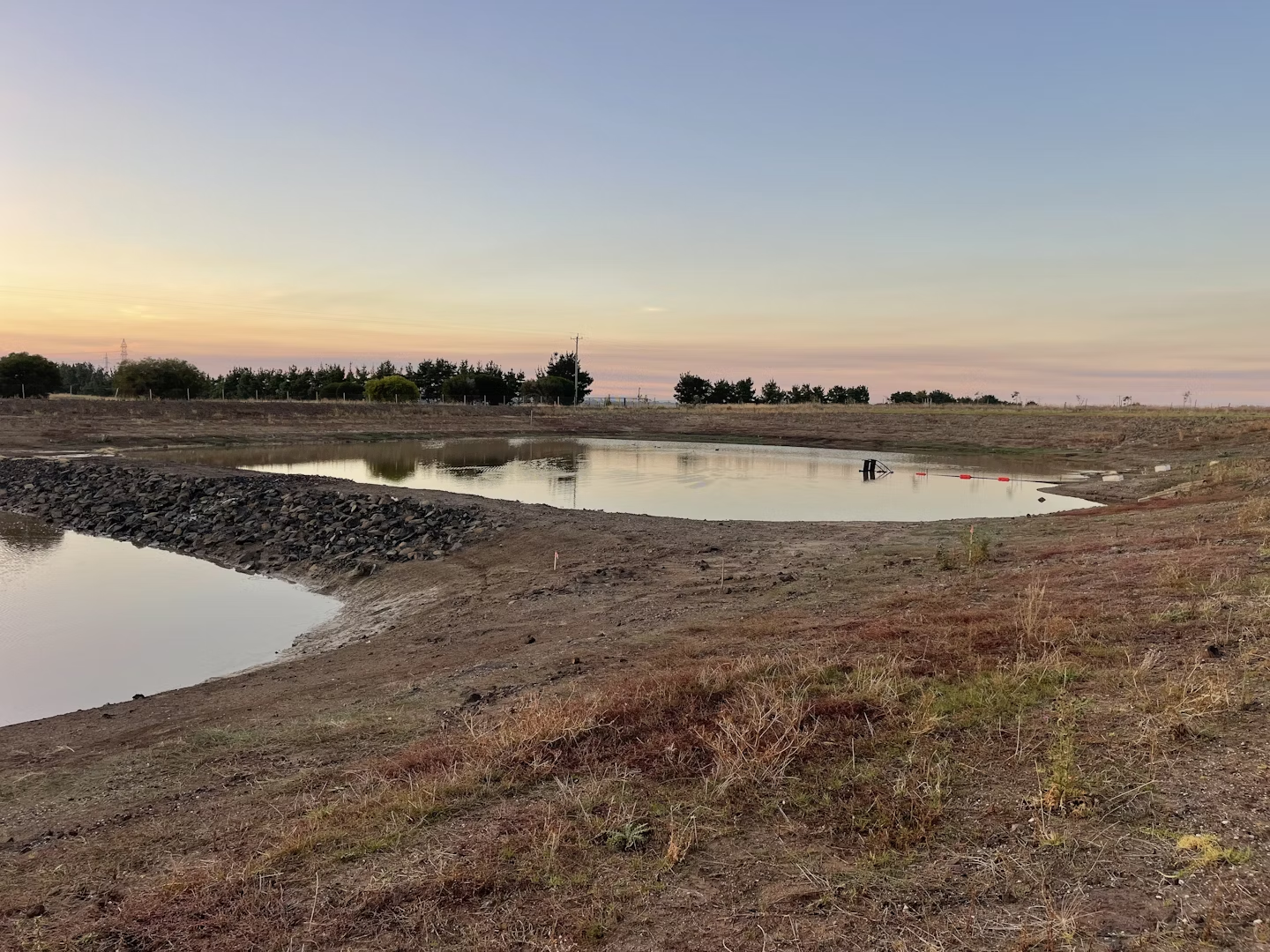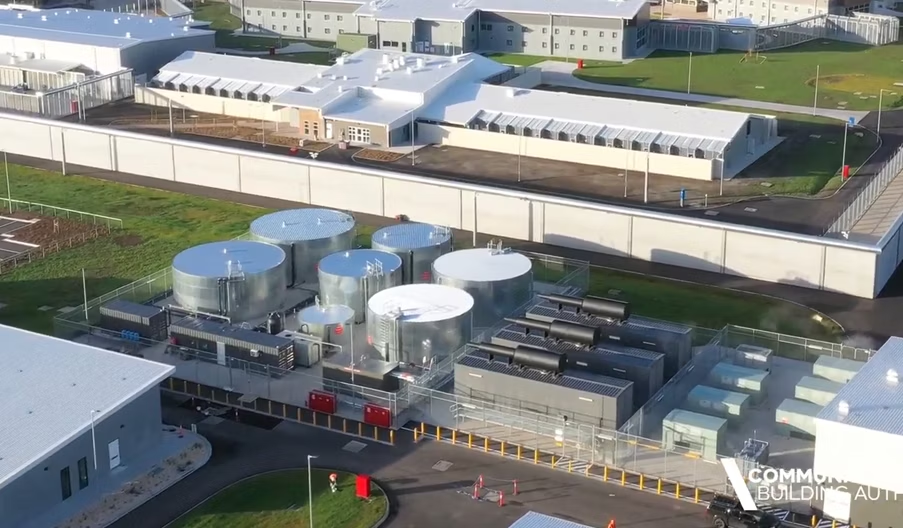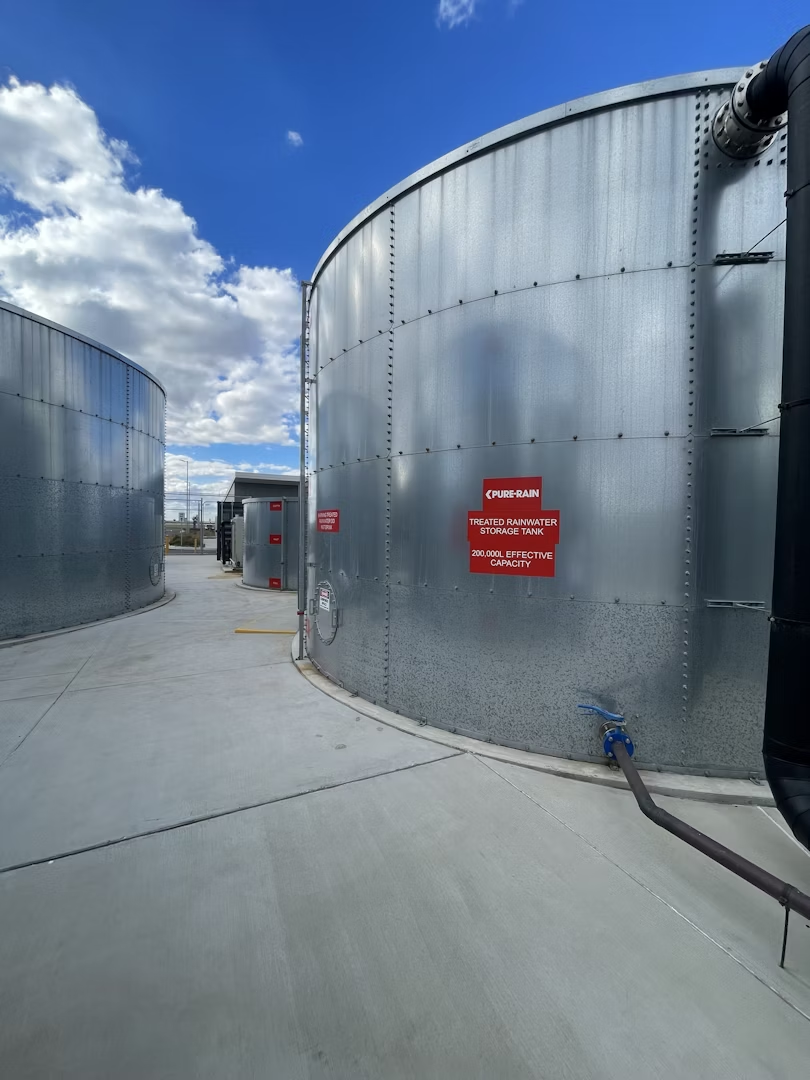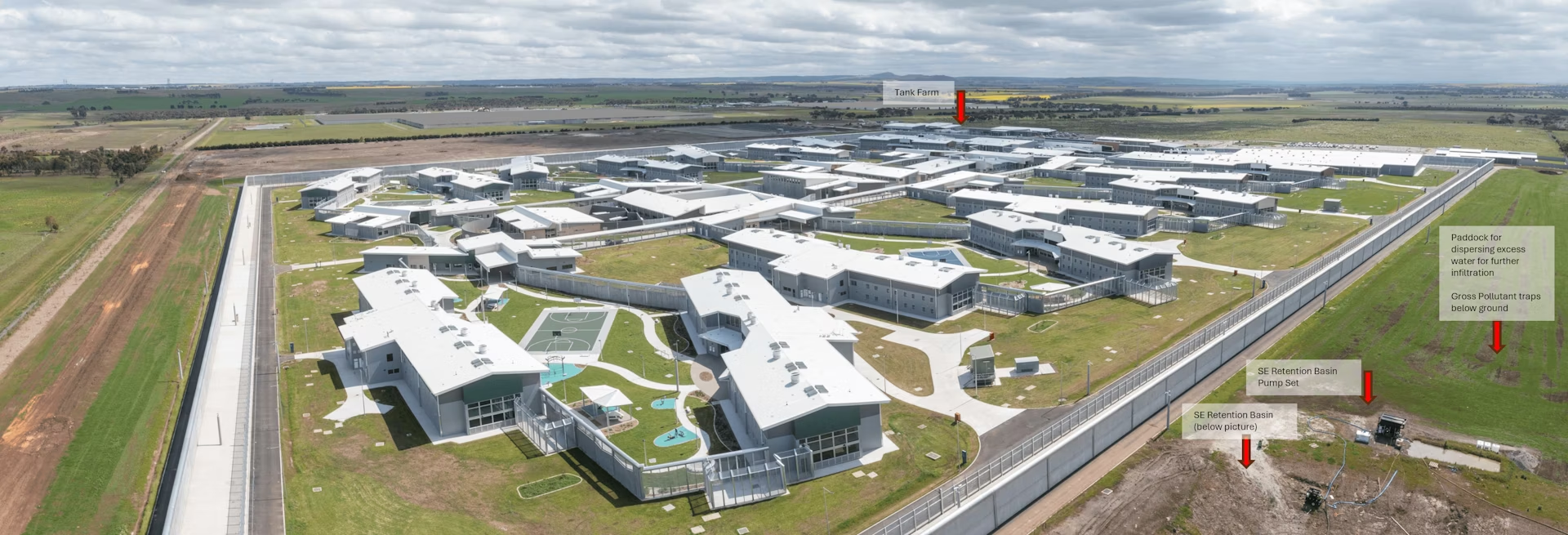Western Plains Correctional Centre – Environmental Outcomes
Western Plains Correctional Centre is a 1,248 bed state-of-the-art maximum-security male prison. Which embodies a commitment to sustainability and safety focusing on rehabilitation and reintegration for people in
custody. It is the first new-build custodial facility in Australia to be awarded an IS Certification for outstanding sustainability outcomes.
The project team has achieved an IS v2.0 ‘Silver’ Design and As Built Certification. This is underpinned innovative rainwater harvesting and treatment systems for non-potable water supply, surpassing benchmarks and achieving an 46% reduction in whole of life water demand. This translates to an annual supply of 28ML of harvested rainwater. Our approach incorporates stormwater drainage, retention basins, tank farm, water treatment and advanced water management solution, ensuring efficient water use for non-potable water applications within the facility. This project showcases our dedication to environmental stewardship and community impact. Together, we are shaping a sustainable future.
Describe WHAT you have done and HOW you have done it. Please provide a summary of your initiative, innovation, or approach.
Western Plains Correctional Centre is a new maximum-security male prison with 1,248 beds, dedicated to sustainability and safety while emphasising rehabilitation and reintegration for people in custody. It is the first new-build custodial facility in Australia to receive an Infrastructure Sustainability (IS) Certification for exceptional sustainability outcomes, including innovations in sustainable suppliers, water benchmark exceedance, as well as installation of a large solar farm. This submission focuses specifically on water outcomes, contributing over 20 out of 45 points in the IS rating.
The project team achieved an IS v2.0 ‘Silver’ Design and As Built Certification, aiming to establish a leading correctional facility for Victoria. Led by the Department of Justice and Community Safety (DJCS), the team chose to pursue IS rating certification to assess sustainable outcomes. In a demonstration of sustainability leadership, the project was an early adopter of the IS v2.0 Design and As Built Rating, setting an ambitious target of ‘Silver’ for a new asset class and new proponent under the new IS v2.0 framework.
The project set and achieved a number of objectives to significantly reduce potable water demand
• 40% reduction in operational potable water demand
• 20% water supply for operations from rainwater harvesting
• 30% water supply for construction
• ISC Wat-1 Level 3 (30% whole of life WoL water demand reduction)
Through a comprehensive approach, the project exceeded expectations by achieving a remarkable WoL water demand reduction of 46% from the base case, verified in the IS rating.
An advanced technical solution was developed to provide an annual supply of 28 ML of harvested and treated rainwater for 100% of non-potable water supply within the facility (1,400 ML over the asset’s useful life.)
The solution integrates stormwater drainage, gross pollutant traps (GPTS), retention basins, a tank farm, water treatment systems and advanced water management system.
The stormwater drainage system collects runoff from roofs, the car park and within the facility perimeter. GPTs filter debris and pollutants before water enters the SE retention basin. Overland flows from outside the facility perimeter follow natural drainage lines to reduce sediment. The SE retention basin has a capacity of 33,503 m³, sized for local rainfall and non-potable water demands (28ML annually).
Rainwater collected in the SE Retention Basin is pumped to the tank farm, which contains tanks for untreated rainwater, fire water and treated water, and is serviced by a dedicated rainwater treatment train. This facility processes harvested rainwater to meet reuse standards within the facility.
The benefits were extended by early implementation of the SE retention basin during construction allowed early access to stormwater collection and reuse for approximately 56% (33.5 ML) of construction water needs.
The treated rainwater is distributed for non-potable uses including toilets, urinals, laundries and landscape irrigation, managed by an advanced water management system that allows real-time monitoring of water retention, treatment. The project manages excess stormwater, via a specialised paddock sprinkler system to disperse excess water and allowing access to excess water by accessed neighbouring properties.
What were the OUTCOMES and how were those outcomes shared?
In support of the overarching project targets listed above, the project identified the following objectives for the Green Infrastructure Plan on the project:
• Element 1 WSUD Stormwater Treatment: Treat site runoff water to CSIRO best practice guidelines
• Element 2 Rainwater harvesting: Reduce water demand by 20%
Both the WSUD Stormwater Treatment and rainwater harvesting systems have been installed and tested, with defects rectified during the 12-month defects and liability period post-construction.
The Ecoceptor and Stormceptor systems have been installed and successfully commissioned, feeding the SE water retention basin for effective harvesting and infiltration.
Water quality testing confirms compliance with CSIRO guidelines, with final tests conducted on 12 May 2023 validating preparedness for handover to the Department of Justice and Community Safety and facilitating water accessibility for neighbouring farmers.
The volume of stormwater harvesting capacity has far exceeded the target of 20%, by being designed, specified and installed to meet over 40% of the operational water demand.
The outcomes are as follows:
Outcome 1: Water Demand Reduction
• 46% of operational water demand is met through efficient water fixtures and rainwater harvesting
• This equates to 28 ML supply of harvested rainwater annually and 1,400 ML over the useful life of the asset.
• Irrigation only to external landscaping. Internal landscaping relies on rainfall only.
Outcome 2: Improved stormwater management
• 100% stormwater capture and treatment prior to legal point of discharge (SE Retention Basin)
• Overland flows directed to the SE retention basin via natural drainage lines with natural sediment controls implemented
• Can support 1 in 100 year rainfall events
• Excess collected stormwater is dispersed via specialised paddock sprinkler system onsite to avoid damage from overtopping SE retention basin
Outcome 3: Improved resilience
• Provides facility with water security during droughts or other major disruptions to water supply
• Reduces impact of the facilities water demand on the local community water supply, improving community water resilience
• Water supply could potentially be used in fire emergencies to improve resilience for both the prison and local community
• Excess harvested water available to neighbouring properties further improving community water resilience
Outcome 4: Construction Non-Potable Water Supply
• 56% of construction water harvested from the SE retention basin, according to water monitoring data
• This equates to 33.5 ML supply of harvested water during the construction period.
Outcome 5: Improved Water Chiller Water Demand
• Improved thermal performance of the buildings design reduced the cooling demand on the central chillers
• Highly efficient chiller selection
IS Rating Verified Outcomes
• Con-2 – Level 1 (0.8 points)
• Res-2 – Level 2 (1.75 points)
• Gre-1 – Level 3 (3.5 points)
• Env-1 – Level 1 (0.47 points)
• Wat-1 – Level 3 (4.2 points)
• Wat-2 – Level 2 (2.1 points)
• Inn-1 – 1 point for exceeding the benchmark in Wa1-1
The highly successful water outcomes of the project have been shared internally through DJCS, Corrections Victoria, John Holland and NDY as a case study for stormwater management and rainwater harvesting for non-potable water use in operations and construction.
The DJCS Climate Action, Planning and Environment (CAPE) team have presented to the Facility Operations (Corrections Victoria) regarding the ISC process applied to the project and the key outcomes. The team have also captured project lessons and outcomes in the CRPP Project Closure Report and Lessons Learnt Activities, to be made available for future projects.
John Holland has utilised the insights gained from delivering the Western Plains Correctional Centre to support the development of sustainability strategies for similar projects, including the Queensland Train Manufacturing Project. Specifically, benchmarking fuel and water usage during construction has been instrumental in identifying opportunities for water reduction and establishing benchmark targets.
NDY have shared the project success internally to inspire sustainability and engineering solutions for future projects. The ISAP for the project has shared insights into measuring sustainability initiative outcomes in multiple IS credits to build up a successful IS rating submission in the IS Design and As Built Technical Working Group. The lesson emphasised that well designed and implemented initiatives can have many benefits including green infrastructure, resilience, reducing environmental impacts, using non-potable water sources and improving operational water efficiency.
Describe WHO benefited from your initiative, innovation, or approach?
The rainwater harvesting initiative has provided significant benefits to various stakeholders, including Corrections Victoria, local communities, the environment and Barwon Water. Overall, the initiative contributes to regional water security, operational resilience, technology demonstration and environmental sustainability, benefiting adjacent properties, groundwater reservoirs and potentially emergency firefighting efforts, all while supporting a strategic water management approach in response to growing water demand in the region.
For Corrections Victoria, the initiative is expected to result in reduced operating costs and increased resilience for the prison, with valuable lessons applicable to other prisons for evaluating the feasibility of implementing similar scale green infrastructure for rainwater harvesting.
Properties adjacent to the facility may request access to excess water resources which will reduce their overall water demand and contribute to enhanced community water resilience during times of drought or water supply disruptions.
From an environmental perspective, the initiative has achieved no stormwater runoff to the environment without capture and treatment prior to infiltration and discharge offsite. The water is infiltrated through the basin and a dedicated paddock sprinkler infiltration system which facilitates groundwater recharge.
For context, Barwon Water, the local water corporation is facing increasing strain due to population growth. Adding a prison population of over1200 people in custody into the area has potential to cause further strain on the regions’ water supply. The prison’s stormwater management and rainwater harvesting strategy aligns to Barwon Waters’ Water Adaptation Strategy for securing future water supplies through technological solutions aimed at water security, fit for purpose water and water for environmental and cultural values. As an example Barwon Water’s Water Adaptation Strategy identifies that it needs to find or save 53ML of water every year to meet community needs under a worst case scenario. The prison was forecast to add another 67ML of water demand into the region annually, so the rainwater harvesting contributing 27ML to the prison operations annually makes a significant contribution to the water resilience of the region serviced by Barwon Water.
The overall effort to reduce the prisons’ water demand from Barwon Water, share excess treated stormwater with neighbours and community stakeholders, which in turn reduces their water demand from Barwon Water, assists with reducing water extraction from Victorian Rivers. This supports Barwon Water to leave water in the riverine systems for environmental flows and cultural values.
What LEGACY and UN SDG CONTRIBUTION was achieved?
The rainwater harvesting initiative directly contributes to the United Nations Sustainable Development Goal 6, particularly Target 6.4, which aims to substantially increase water-use efficiency across all sectors while ensuring sustainable withdrawals and supply of freshwater to address water scarcity.
By implementing a comprehensive rainwater harvesting system, we have significantly improved water-use efficiency within the prison by achieving a 46% reduction in operational water demand. This reduction not only alleviates pressure on local freshwater resources but also supports sustainable withdrawals through effective water management techniques. The initiative employs strategic stormwater drainage and treatment systems, ensuring that captured rainwater is used efficiently for non-potable applications, promoting the responsible use of available water resources.
Furthermore, the project aligns with sustainable practices by facilitating groundwater recharge and maintaining riverine environmental flows, which is essential for ecosystem health. With the potential benefits extending to neighbouring communities, access to treated excess rainwater can alleviate water scarcity, particularly during periods of drought or supply disruptions.
The project showcases the feasibility and benefits of sustainable water management practices. The initiative serves as a model for other sectors and facilities to adopt similar strategies, thereby contributing to the broader goal of reducing the number of people suffering from water scarcity.
In summary, this initiative exemplifies how innovative water management solutions can enhance water-use efficiency, promote sustainable freshwater supplies and ultimately reduce the number of individuals affected by water scarcity in the region.






